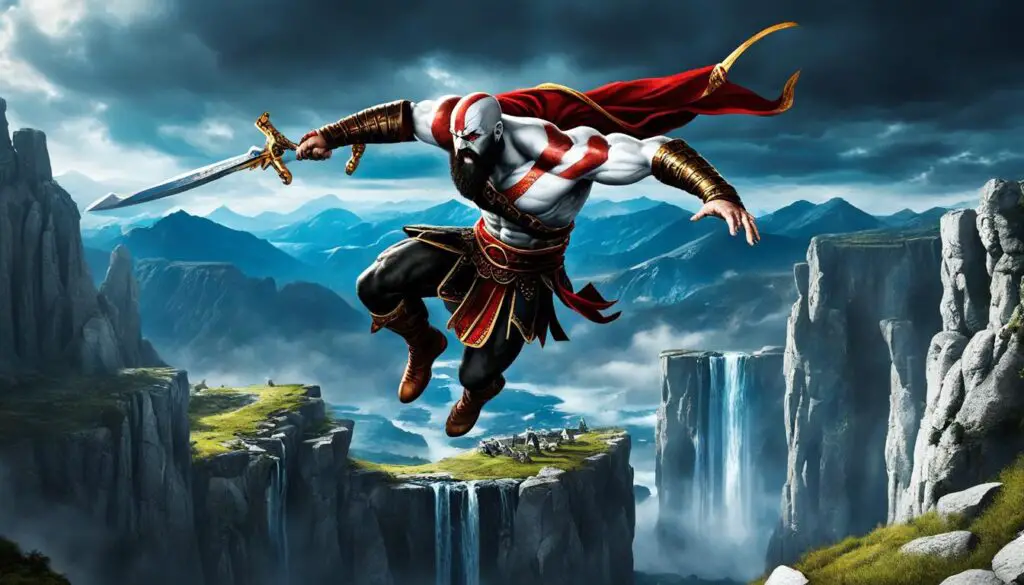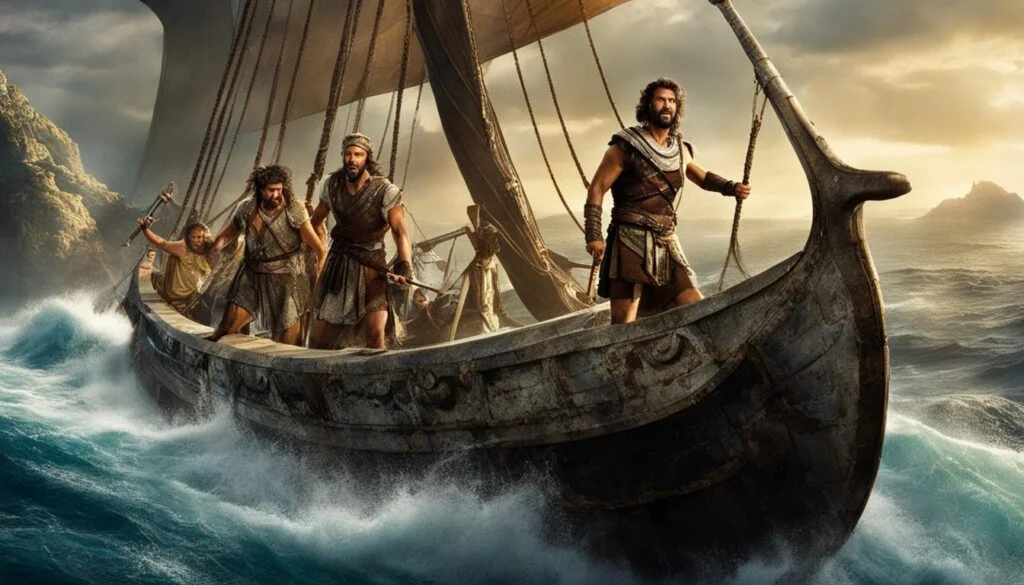The transition of Kratos from Greek to Norse mythology is a captivating aspect of the God of War series. Fans have been intrigued by how Kratos ends up in Norse Mythology and his journey in this new realm. In this article, we will delve into the details of Kratos’ transition, his involvement, and his role in Norse Mythology.
In God of War 3, Kratos brought about the end of the world through a devastating flood. But what happened between the flood and the beginning of God of War 4? According to the Creative Director of the series, Cory Barlog, each pantheon of gods exists on the same plane but is beholden to their own territories within that plane. This suggests that mortals, like Kratos, can move between different mythological realms. It is believed that Kratos survived the flood and relocated to the realm of Midgard, which is part of Norse mythology.
Key Takeaways:
- Kratos transitions from Greek to Norse mythology in the God of War series.
- Players are left wondering how Kratos ends up in Norse mythology, and his journey is a central plot point.
- According to Cory Barlog, each pantheon exists on the same plane but has its own territories.
- Kratos’ survival of the flood leads to his relocation to the realm of Midgard in Norse mythology.
- This transition opens up new possibilities for exploring different cultures and mythologies in the God of War series.
Kratos’ Journey to Midgard
The exact details of how Kratos ended up in Midgard are not explicitly explained in the game. However, there are several hints and clues that provide some insight. In God of War 4, players encounter Tyr’s Bridge, which had been submerged for at least 150 years. This suggests that Kratos has been in Midgard for a significant amount of time.
Additionally, players can find a vase with Kratos’ face on it within Tyr’s Vault, indicating that Kratos’ legend has been passed down in Midgard or he has forged another legend of renown.
- This image depicts Kratos on his journey to Midgard, the realm of Norse mythology.
- It showcases the epic scope and adventurous nature of Kratos’ relocation to a new pantheon of gods.
- As Kratos makes his arrival in Midgard, players are set to embark on an exciting and immersive new chapter in the God of War series.
The Impact of the Flood

The devastating flood in God of War 3 had far-reaching consequences on the pantheons of various mythologies. One of the lasting impacts of this cataclysmic event can be observed in God of War 4, where water plays a prominent role in the game’s environment and mechanics.
Kratos, the protagonist, frequently relies on a boat as his primary means of transportation in the game. This suggests that the flood may have had a profound effect on the connectivity between different territories within the pantheons, resulting in easier movement for Kratos between various mythologies.
As players delve further into the game, they can witness how the flood’s aftermath has shaped the mythological realms. The inundation may have caused shifts in geography and the redistribution of power among the pantheons. Such changes create opportunities for Kratos to navigate his way through the transformed landscapes and encounter new challenges and encounters.
The Flood’s Effect on the Pantheons
The flood in God of War 3 signaled a disruption in the balance of power among the gods and goddesses of various mythologies. Deities who once held dominion over specific territories might have lost influence or found themselves subjected to new alliances in the post-flood era.
This dynamic shift in the pantheons not only presents Kratos with interesting conflicts and alliances but also provides players with a captivating exploration of the consequences of the flood on mythological realms.
The Flood’s Effect on Transportation
The flood also radically altered the world’s physical landscape, creating new waterways and pathways that become integral to Kratos’ journey. Navigating through treacherous seas and uncovering hidden realms has become a crucial aspect of the game, with Kratos utilizing his boat to venture into uncharted territories.
By integrating water as a central element, the flood’s impact on transportation adds depth and complexity to the gameplay, offering players a novel and immersive experience.
Connections Between Mythologies

In God of War 4, Kratos and Atreus embark on a journey that reveals intriguing connections between different mythologies. One significant discovery they make is a carving of Tyr, the Norse god of war, navigating between realms. This carving showcases symbols from various mythologies, including the Greek Omega symbol, suggesting a physical connection between the pantheons.
This revelation opens up exciting possibilities for the series to explore other cultures, myths, and legends beyond the realm of Norse mythology. By delving into shared symbols and interconnectedness, the God of War franchise can showcase a rich tapestry of diverse pantheons and their intriguing relationships.
This image depicts the carving of Tyr and serves as a visual representation of the connections between different mythologies in the game. It highlights the physical link that allows Kratos to navigate between pantheons, bridging the gap between distinct cultural narratives.
The exploration of interconnected mythologies not only offers players a deeper understanding of the world of God of War but also introduces fresh storytelling opportunities. Players can expect to encounter shared symbols, themes, and characters from various pantheons, creating a fascinating and immersive experience.
Conclusion
Kratos’ transition from Greek to Norse mythology in the God of War series brings an exciting shift to the game’s setting and narrative. While the exact details of how Kratos ended up in Midgard are not explicitly explained, there are hints and clues that suggest his relocation. The impact of the catastrophic flood in God of War 3 and the intriguing connections between various mythologies in God of War 4 play a significant role in Kratos’ involvement in Norse mythology.
The series delves into Kratos’ journey and his evolving role as he enters the realm of Norse mythology. This transition allows players to explore a rich and immersive world steeped in Norse folklore and legends. Through Kratos’ experiences, players are introduced to the captivating and often treacherous realms of Midgard, Asgard, and the Nine Realms, encountering iconic Norse gods, creatures, and mythological figures along the way.
As Kratos continues to navigate the Norse realms, his presence not only challenges the existing order but also sets the stage for potential interactions between different pantheons. The incorporation of Norse mythology in God of War expands the game’s scope, inviting players to contemplate the complexities and interconnectedness of various mythologies.
FAQ
How does Kratos end up in Norse Mythology?
The exact details of how Kratos ended up in Norse Mythology are not explicitly explained in the game. However, there are hints and clues that suggest his relocation.
What is Kratos’ journey to Midgard?
After surviving battles against mortals and gods, Kratos is believed to have relocated to the realm of Midgard, which is part of Norse mythology.
What is the impact of the flood in God of War?
The flood that occurred in God of War 3 has lasting impacts on the pantheons of different mythologies, including Norse. Water is a prominent feature in God of War 4, suggesting that the flood may have better connected the various territories of the pantheons.
Are there connections between different mythologies in God of War?
Throughout God of War 4, there are hints of connections between different mythologies. A carving of Tyr traversing between realms features symbols from various mythologies, including the Greek Omega symbol, suggesting a physical connection between the pantheons.
What is the significance of Kratos’ transition to Norse Mythology?
Kratos’ transition from Greek to Norse Mythology marks a significant shift in the game’s setting and storyline. It opens up the opportunity for the series to explore other cultures, myths, and legends beyond Norse mythology.




